Tutorial:Circuit network cookbook
Introduction
WORK IN PROGRESS!!
This page provides examples of simple circuit network designs that others can use, combine and modify. They are designed to be as easy to understand as possible.
Some of these designs are mine and some are based on ones I have seen on the forums or Reddit.
Oil Setups
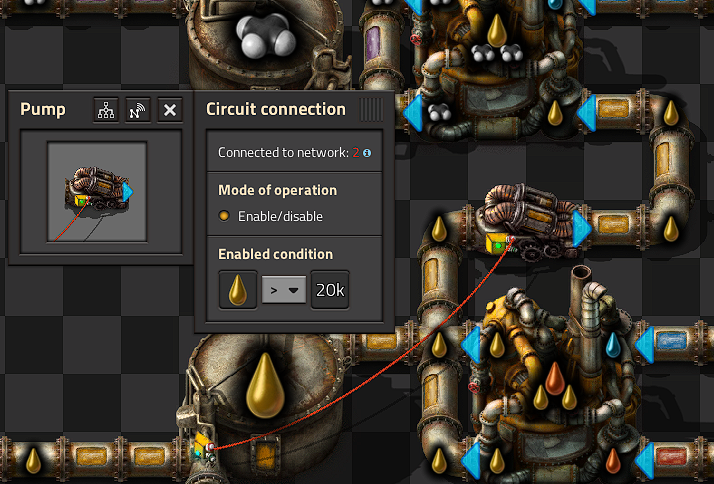
Light Oil Cracking
- This circuit provides balanced light oil and petroleum gas production by cracking excess light oil into gas.
- The Small pump is connected to the Storage tank by a Red Wire.
- The small pump has an enabled condition set to Light Oil > 2000.
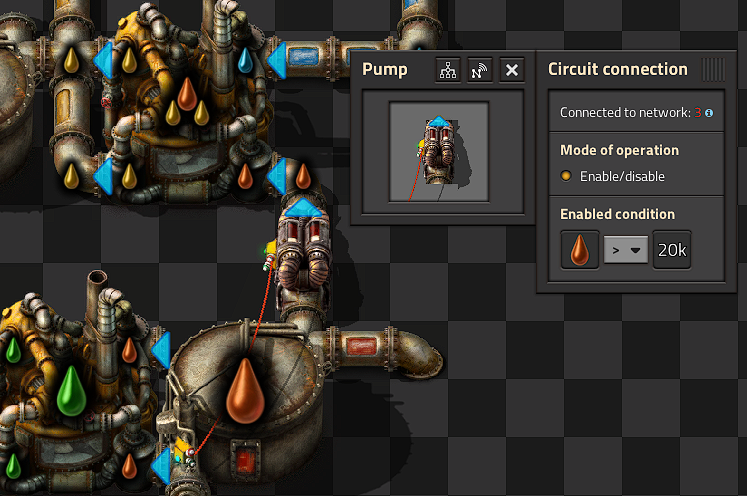
Heavy Oil Cracking
- This circuit extends on the previous circuit by adding heavy oil cracking to provide lubricant as well.
- The Small pump has an enabled condition set to Lubricant > 2000.
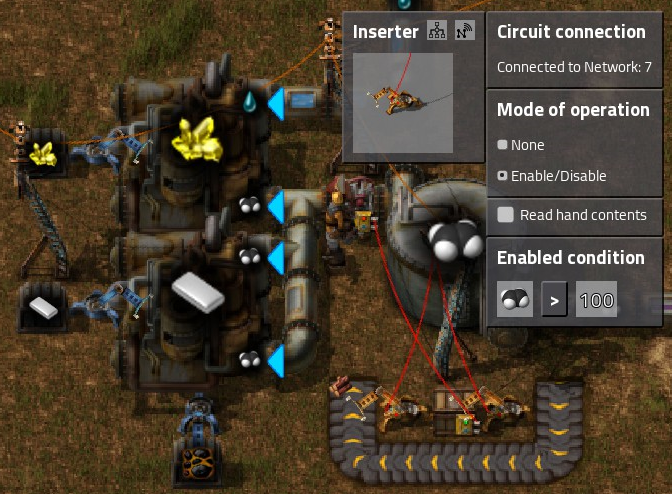
Petroleum split evenly between plastic and sulphuric acid
- This circuit buffers gas in the tank until there is at least 100, then it lets the tank drain until there is less than 50 and the cycle repeats.
- It has a few elements that work together to do achieve this.
- Firstly the Small pump is connected to the Wooden chest by a Red wire and the enabled condition on the Small pump is set to Raw wood > 0.
- Both of the basic inserters are connected to the Storage tank by Red Wires.
- The enabled condition on the left inserter is Petroleum gas > 100
- The enabled condition on the right inserter is Petroleum gas < 50.
- You will need to insert a single "Raw wood" into the chest to make it all work.
- It is also possible to do this with combinators instead of the inserters, belt and the Wood chest.
Lights
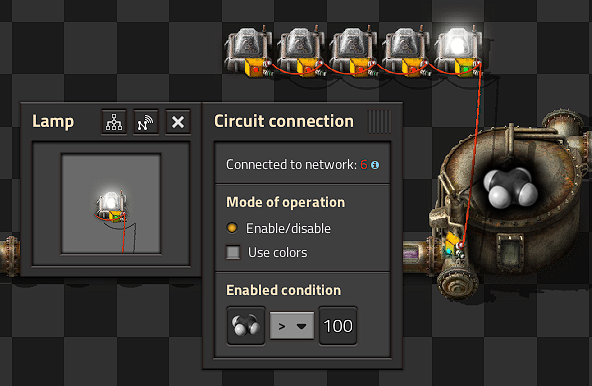
Conditional Lights
- In this circuit we connect a series of lights to a Storage Tank.
- By setting different conditions on each light we can build an indicator strip.
- The Enabled condition of the first light is Petroleum gas > 100.
- The others light up when gas is greater than 200, 300, 400 & 500 respectively.
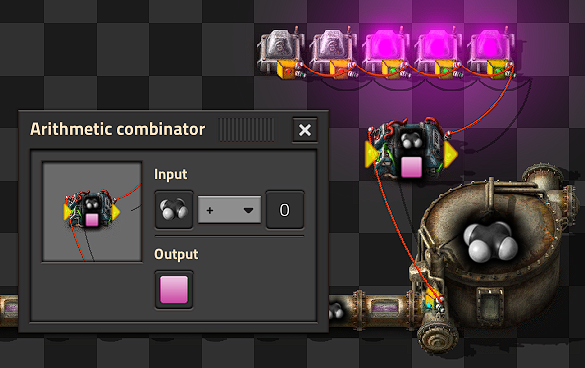
Colored Lights
- To light a lamp with a color rather than white, you need to do two things.
- 1. Send a colored signal to the lamp
- 2. Select the "Use colors" checkbox on the lamp.
- In this case we want to convert a Petroleum gas singal into a pink signal.
- We can do this with an Arithmetic combinator, setting the input to Petroleum Gas + 0 (the constant 0 not the signal 0) and set the output to the Pink signal (on the bottom row of the last tab of signals.)
Misc
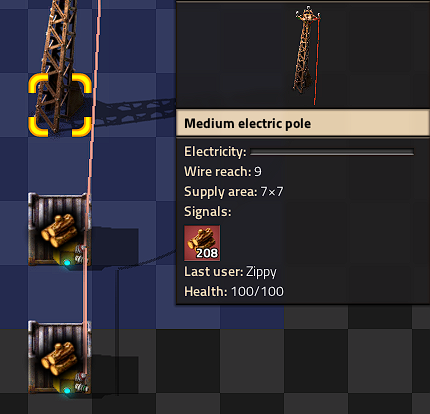
Multiple Storages
- If you connect multiple chests to a pole, the pole displays the sum of items in all the chests.
- This also works with Storage tanks.
- and roboports
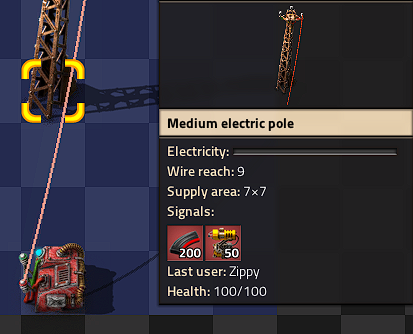
Constant combinator
- With a constant combinator you can generate any signals you my need.
- In this example we have generated a signal of 50 Laser turrets and 200 Piercing round magazine.
- Constant combinators are not of much use on their own but we shall use them later.
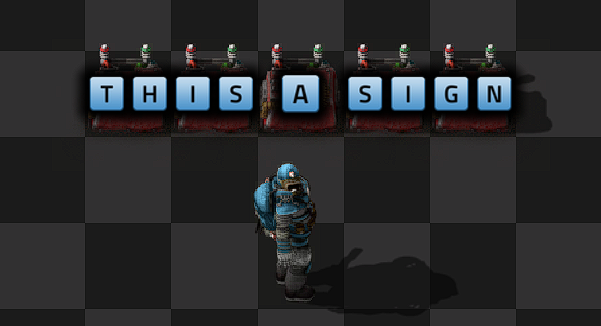
Constant combinator signs
- You can use constant combinators to make signs.
- just set the letter signals in the combinator, etch combinator can display 2 characters side by side.
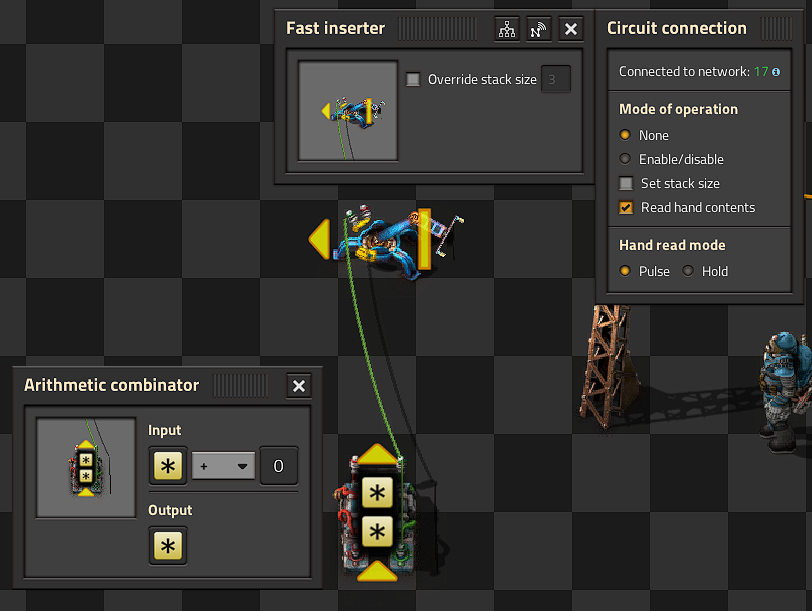
Memory Cell
- Basic memory cell that counts all the items moved by the inserter
- The Fast inserter is connected to BOTH ends of the arithmetic combinator.
- If the fast inserter hasn't picked anything up this tick the input to the Arithmetic combinator is the same as and output and hence the values are persisted.
- When the fast inserter does pick something up its value is added to the output from the previous tick thus incrementing that item.
Inserters
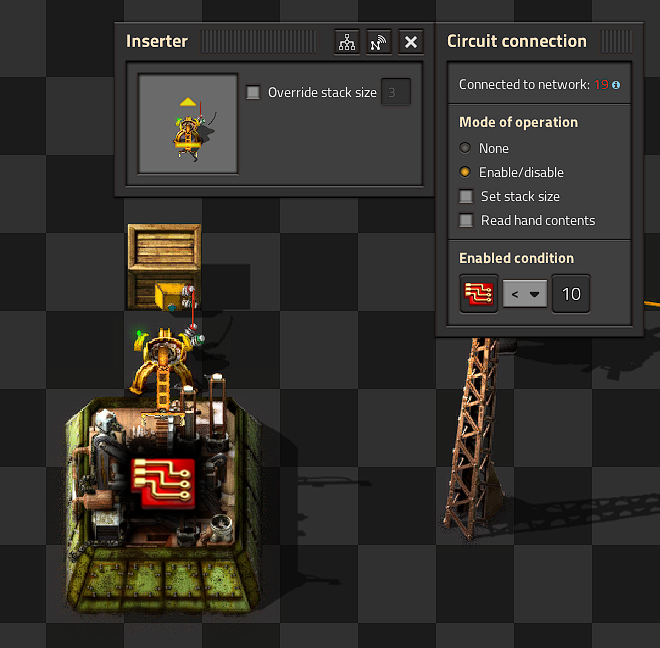
Limit items placed into a chest
- The Basic inserter is connected to the Wooden chest using a Red wire.
- The inserter's enabled condition is Advanced Circuit < 10.
- In reality this means the inserter may place more than 10 Advanced circuits in the chest because it could pick up-to 3 at once.
- This effect can be even greater with Stack inserters because of their large carrying capacity.
- This technique still gives far greater control than limiting the inventory on the chest.

Keeping outpost stocked with specified items
- This circuit keeps a storage chest at an outpost stocked with customised levels of different items.
- For example you could keep an outpost stocked with 50 laser turrets and 200 piercing magazine rounds but not have to worry about it being over filled.
- The storage chest is attached to the input of the Arithmetric combinator (left side in the picture) with a Red wire.
- Another couple of Red wires join the output of the Arithmetric combinator (right side) to the constant combinator and to the filter stack inserter.
- The Arithmetric combinator multiples each input value (from the storage chest) by "-1".
- Finally the filter stack inserter's mode of operation is set to "Set filters".
- So the input to the filter stack inserter is <Constant combinator> - <Storage chest contents> and the filter is set to filter the item of greatest demand.
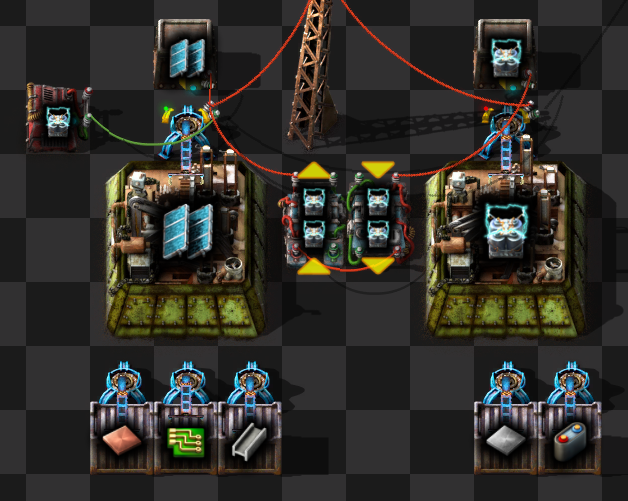
Balanced Solar panel / Accumulator Production
- This circuit balances production of Solar panels and Accumulators to a desired ratio in my case 24:20.
- The first Arithmetic combinator takes the number of accumulators in the chest and multiples it by 24.
- The second Arithmetic combinator takes the output of the first combinator and divides it by 20.
- This gives us the a number of accumulators that we can directly compare to the number of Solar panels in both inserters.
- If the number of accumulators is greater you need more Solar panels, if the number of Solar panels is greater you need more accumulators so turn inserters on accordingly.
- However, if they are equal neither machine does anything. So we add a single accumulator to one of the inserters using a constant combinator and a wire of the other color thus breaking the deadlock.
Sushi Belts
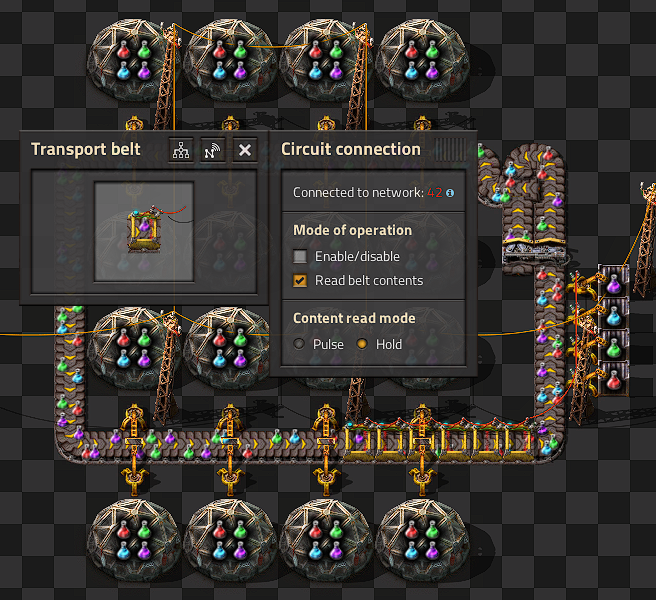
Reading Belt Design
- Six belts in a row are connected with Red wire and set to Read belts contents and Hold
- This Red wire is then connected to the inserters that insert onto the belt.
- Read hand contents is unselected for all inserters.
- Mode of operation is set to Enable/Disable on all inserters.
- The first inserter is enabled when Science pack 1 = 0
- The other inserters are set similarly for the other science packs.
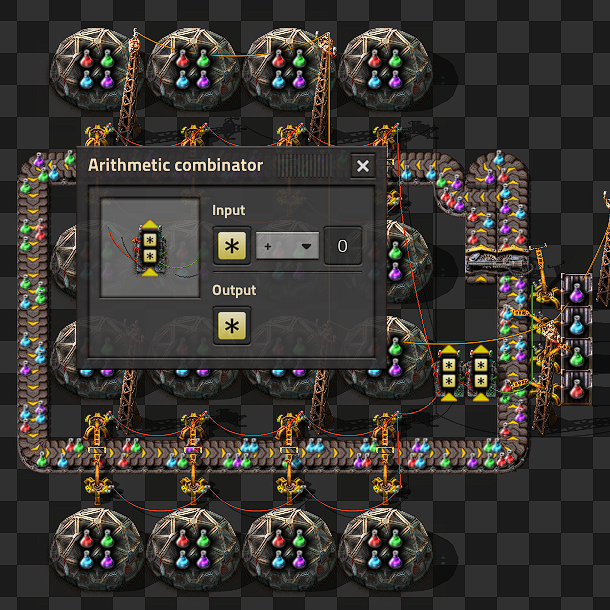
Memory Cell Design
- This circuit counts the number of items of each type on a looping belt by counting the numbers that are added and removed from the belt by inserters.
- Each inserter that takes items off the belt is connected together with Red wire and each of these inserters is set to Mode of operation none, Read hand content selected and Hand read mode pulse.
- These inserters are connected to the input of the left arithmetic combinator.
- The left arithmetic combinator multiples each input by -1 and outputs it to each.
- The right arithmetic combinator is displayed in the